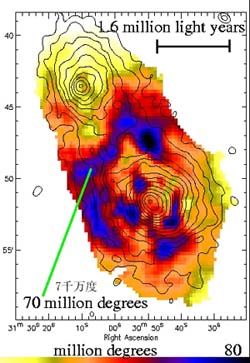(Clearwisdom.net) Ongoing research by an international team of astronomers is providing new insights into cataclysmic cosmic collisions between galaxy clusters.
Using the world's most powerful X-ray space observatory, the team is unraveling the complex interactions that take place in the "traffic pile-ups" that occur as clusters containing hundreds of galaxies and trillions of solar masses of gas and dark matter interact and merge.
Speaking on Friday at the RAS National Astronomy Meeting in Birmingham, Dr. Elena Belsole (University of Bristol) presented new results obtained with ESA's orbiting XMM-Newton observatory. The images and other data reveal an environment racked by violent shock waves that squeeze and compress the intra-cluster gas, raising its temperature to many millions of degrees.
|
|
Only 5% of the mass of galaxy clusters lies in stars and galaxies. The space between the galaxies is filled with gas which is so hot (10--100 million degrees Celsius) that it can only be seen at X-ray wavelengths.
By using space-based instruments able to see at X-ray wavelengths, Belsole's team has been able to measure the origins and energy of X-rays from galaxy clusters. From the positional information, they were able to map the distribution of the gas in the clusters. From the X-ray energy, they were able to measure the gas temperature. By combining the two, they could map the temperature structure of the cluster gas.
Belsole's team has recently investigated three different merging clusters, each made up of hundreds of galaxies. One of these, known as Abell 1750 (A1750), is a young merger located 1.1 billion light years from Earth. It involves two clusters, separated by more than 3 million light years, which are just starting to interact.
Each of these colliding clusters has a total mass about 500 trillion times that of the Sun, and is moving at a speed of around 1,400 km/s. The violent interaction between them causes shocks and compression of the intra-cluster gas, producing an arc-like region of gas between the two with a temperature of 70 million degrees Celsius. The collision will reach its climax in 1.2 billion years, when the cores collide and the energy release is at its maximum.
A more complicated example is A3266, located 800 million light years from Earth. Two clusters, of unequal mass, are seen just after the point of closest encounter. This creates a hot, boomerang-shaped region where a shock wave is propagating in the direction of motion of the smaller, infalling cluster. A1750 will look like this in 1.2 billion years.
An older example is A3921, located 1.2 billion light years from Earth. In this case, the very asymmetric morphology and temperature distribution reveal that two clusters, again of unequal mass, have already had their first encounter. The smaller cluster, about three times less massive than the main cluster, was almost totally destroyed by the encounter. The collision shredded the smaller cluster, at the same time producing a hot region of shocked gas stretching from the centre of the main cluster.
"This research shows the violent manner by which the largest structures in the Universe form, and that the formation has happened in the recent past," said Belsole. "The process is still taking place today. In several billion years, the group of which our galaxy, the Milky Way, is a member, will be torn apart as it merges with the nearby Virgo cluster."
Views expressed in this article represent the author's own opinions or understandings. All content published on this website are copyrighted by Minghui.org. Minghui will produce compilations of its online content regularly and on special occasions.
Category: Perspectives










